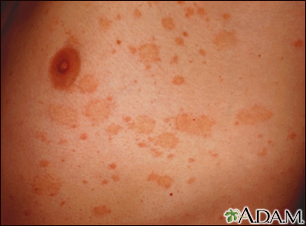Pityriasis rosea
Rash - pityriasis rosea; Papulosquamous - pityriasis rosea; Herald patch
Pityriasis rosea is a common type of skin rash most often seen in young adults.
Images

Causes
Pityriasis rosea is believed to be caused by a virus. It occurs most often in the fall and spring.
Although pityriasis rosea may occur in more than one person in a household at a time, it is not thought to spread from one person to another. Females seem to be more affected than males.
Symptoms
An episode most often lasts 4 to 8 weeks. Symptoms may disappear by 3 weeks or last as long as 12 weeks.
The rash starts with a single large patch called a herald patch. After several days, more skin rashes will appear on the chest, back, arms, and legs.
The skin rashes:
- Are often pink or pale red
- Are oval in shape
- May be scaly
- May follow lines in the skin or appear in a Christmas tree pattern
- May itch
Other symptoms may include:
- Headache
- Fatigue
- Sore throat
- Mild fever
Exams and Tests
Your health care provider can often diagnose pityriasis rosea by the way the rash looks.
In rare cases, the following tests are needed:
- A blood test to be sure it is not a form of syphilis, which can cause a similar rash
- A skin biopsy to confirm the diagnosis
Treatment
If symptoms are mild, you may not need treatment.
Your provider may suggest gentle bathing, mild lubricants or cream, or mild hydrocortisone creams to soothe your skin.
Antihistamines taken by mouth may be used to reduce itching. You can buy antihistamines at the store without a prescription.
Moderate sun exposure or ultraviolet (UV) light treatment may help make the rash go away more quickly. However, you must be careful to avoid sunburn.
Outlook (Prognosis)
Pityriasis rosea often goes away within 4 to 8 weeks. It usually doesn't come back.
When to Contact a Medical Professional
Contact your provider for an appointment if you have symptoms of pityriasis rosea.
Related Information
PatchesReferences
Dinulos JGH. Psoriasis and other papulosquamous diseases. In: Dinulos JGH, ed. Habif's Clinical Dermatology: A Color Guide in Diagnosis and Therapy. 7th ed. Philadelphia, PA: Elsevier; 2021:chap 8.
James WD, Elston DM, Treat JR, Rosenbach MA, Neuhaus IM. Pityriasis rosea, pityriasis rubra pilaris, and other papulosquamous and hyperkeratotic diseases. In: James WD, Elston DM, Treat JR, Rosenbach, MA, Neuhaus IM, eds. Andrews' Diseases of the Skin: Clinical Dermatology. 13th ed. Philadelphia, PA: Elsevier; 2020:chap 11.
Marks JG, Miller JJ, Hollins C. Scaling, papules, plaques, and patches. In: Marks JG, Miller JJ, Hollins C, eds. Lookingbill and Marks' Principles of Dermatology. 7th ed. Philadelphia, PA: Elsevier; 2025:chap 9.
BACK TO TOPReview Date: 10/9/2024
Reviewed By: Linda J. Vorvick, MD, Clinical Professor, Department of Family Medicine, UW Medicine, School of Medicine, University of Washington, Seattle, WA. Also reviewed by David C. Dugdale, MD, Medical Director, Brenda Conaway, Editorial Director, and the A.D.A.M. Editorial team.

Health Content Provider
06/01/2025
|
A.D.A.M., Inc. is accredited by URAC, for Health Content Provider (www.urac.org). URAC's accreditation program is an independent audit to verify that A.D.A.M. follows rigorous standards of quality and accountability. A.D.A.M. is among the first to achieve this important distinction for online health information and services. Learn more about A.D.A.M.'s editorial policy, editorial process and privacy policy. A.D.A.M. is also a founding member of Hi-Ethics. This site complied with the HONcode standard for trustworthy health information from 1995 to 2022, after which HON (Health On the Net, a not-for-profit organization that promoted transparent and reliable health information online) was discontinued. |
The information provided herein should not be used during any medical emergency or for the diagnosis or treatment of any medical condition. A licensed medical professional should be consulted for diagnosis and treatment of any and all medical conditions. Links to other sites are provided for information only -- they do not constitute endorsements of those other sites. © 1997- 2025 A.D.A.M., a business unit of Ebix, Inc. Any duplication or distribution of the information contained herein is strictly prohibited.
